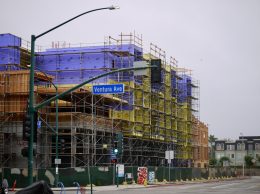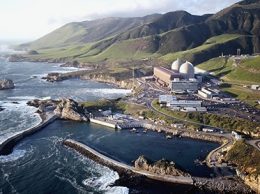Newsom proposes $1.4B to keep Diablo Canyon open
IN THIS ARTICLE
- Energy Topic
- Jorge Mercado Author
By Jorge Mercado Monday, August 15th, 2022
Keeping Diablo Canyon nuclear power plant open could cost California as much as $1.4 billion, under new legislation proposed by Gov. Gavin Newsom on the eve of a hearing to discuss the contested future of the plant on the San Luis Obispo County coast.
On Aug. 11, Newsom proposed, through draft legislation distributed to lawmakers, a $1.4 billion forgivable loan to Pacific Gas & Electric, the owner of the power plant, which could keep it operational until 2035, 10 years beyond its currently schedule closure.
The bill would also exempt Diablo Canyon from the California Environmental Quality Act and several other environmental rules. The bill has yet to be introduced in the Legislature.
On Aug. 12, the California Energy Commission hosted a discussion panel on future of Diablo Canyon. More than 600 people attended via Zoom, and hundreds of them made public comments, the large majority of them against the option of keeping the plant open.
PG&E first announced plans to shut the plant down in 2016. Diablo Canyon is scheduled to begin decommissioning in 2024 and be fully closed by 2025.
But Diablo Canyon is California’s single largest power source, providing about 9% of California’s electricity without producing carbon emissions..
Located on San Luis Obispo County’s coast, Diablo Canyon powers two water reactor units licensed until 2024 and 2025. The plant produces 18,000 gigawatt-hours of electricity and serves more than 3 million California residents, according to the California Energy Commission.
Proponents of keeping the plant open have expressed concern that closing it would leave the state in a vulnerable position, especially during the summer when California uses more energy.
Assemblymember Jordan Cunningham, R-San Luis Obispo, has been one of the biggest proponents for keeping the plant open. It is the largest employer in his district, he said during the Aug. 12 hearing.
“I want to commend the governor,” Cunningham said. “It’s not necessarily an easy thing to reconsider a position in light of new facts and to dig down in the data and do some long term planning for our state’s energy and electricity production future.”
In 2016, the state projected a reduced need for the energy produced by Diablo Canyon.
But, projections by the governor’s office and the Energy Commission indicated that if the plant is decommissioned in 2025, by 2026, the state could be in a 2.5-gigawatt shortage on a random September night.
“We simply are not where we thought we’d be with renewable energy production and coupling that with storage,” Cunningham said. “All of these goals we have, whether it’s housing, decarbonization, electrifying transportation, all have one thing in common, and that is you’re going to need to produce and California’s energy grid will need to be more robust, more reliable, and bigger and expanded compared to present day.”
Greg Haas, a representative for U.S. Rep. Salud Carbajal, D-Santa Barbara, said that if the state decides to extend Diablo Canyon’s life until 2035, it cannot be relied upon to get California to its goal of carbon-neutral power, which has a target date of 2045.
“A roadmap for extension of this facility must be developed with community input and presented to the Central Coast families it will affect most,” Haas said.
Ana Matosantos, the cabinet secretary for Newsom’s office, said keeping the plant open is the state’s “last resort” as it pursues other options like solar and wind power.
State Sen. John Laird, a Democrat from Santa Cruz whose district also includes Diablo Canyon, said the top priority if the plant is to be kept open is to take every safety precaution possible.
He also questioned who would pay to keep the plant running. The California Legislature has until Aug. 31 to determine whether to attach the draft bill to the state’s budget as a trailer bill.
Other options include federal money, including accessing a $6 billion pool under the federal Department of Energy’s Civil Nuclear Credit program. In order to qualify, PG&E must apply by Sept. 6.
“How will we know who pays and how much before we make a commitment to go forward on the extended life of the plant?” Laird said.
Diablo Canyon produces about 2,200 megawatts of electricity, and other power plants around the state will also go offline in the near future, resulting in the loss of about 6,000 megawatts of capacity, said Siva Gunda, vice chair of the California Energy Commission.
Regardless, the majority of public commenters disagreed with the idea of keeping the power plant running beyond 2025.
Jan Boudart, speaking on behalf of Nuclear Energy Information Service, said Diablo Canyon is the “most embrittled reactor vessel in the United States right now.”
Daniel Furth, a retired director of the program on environmental and nuclear policy at UC Santa Cruz, said the each Diablo reactor has “1,000 times the long lived radio activity of the Hiroshima bomb.”
“What would you tell the people of California if your actions resulted in keeping the plant running longer, resulting in a catastrophic meltdown?” he said.
Others criticized PG&E as a whole and its ability to safely operate the plant.
Proponents of keeping the plant said the opposing side was spreading unsubstantiated fear of nuclear power and nuclear waste.
“There is absolutely no evidence that there is a spent nuclear waste problem. It’s never harmed anybody,” said Tim Larson, one of the speakers during the public comment period. “To say nuclear waste is dangerous is absolutely false.”
Kristin States, a small business owner in San Luis Obispo County, said reliable electricity is crucial for her family restaurant to stay open — especially after the problems of COVID-19.
“We shouldn’t be pitting one clean energy source against another or trying to replace reliable clean electricity with unreliable clean electricity. At present, California’s electricity is still mostly produced using natural gas and prices are rising several times faster than the rest of the country,” she said. “We shouldn’t be talking about closing Diablo Canyon until we’ve replaced all fossil fuel resources with clean resources. So please prioritize reliable clean and low cost electricity and keep Diablo Canyon open.”












